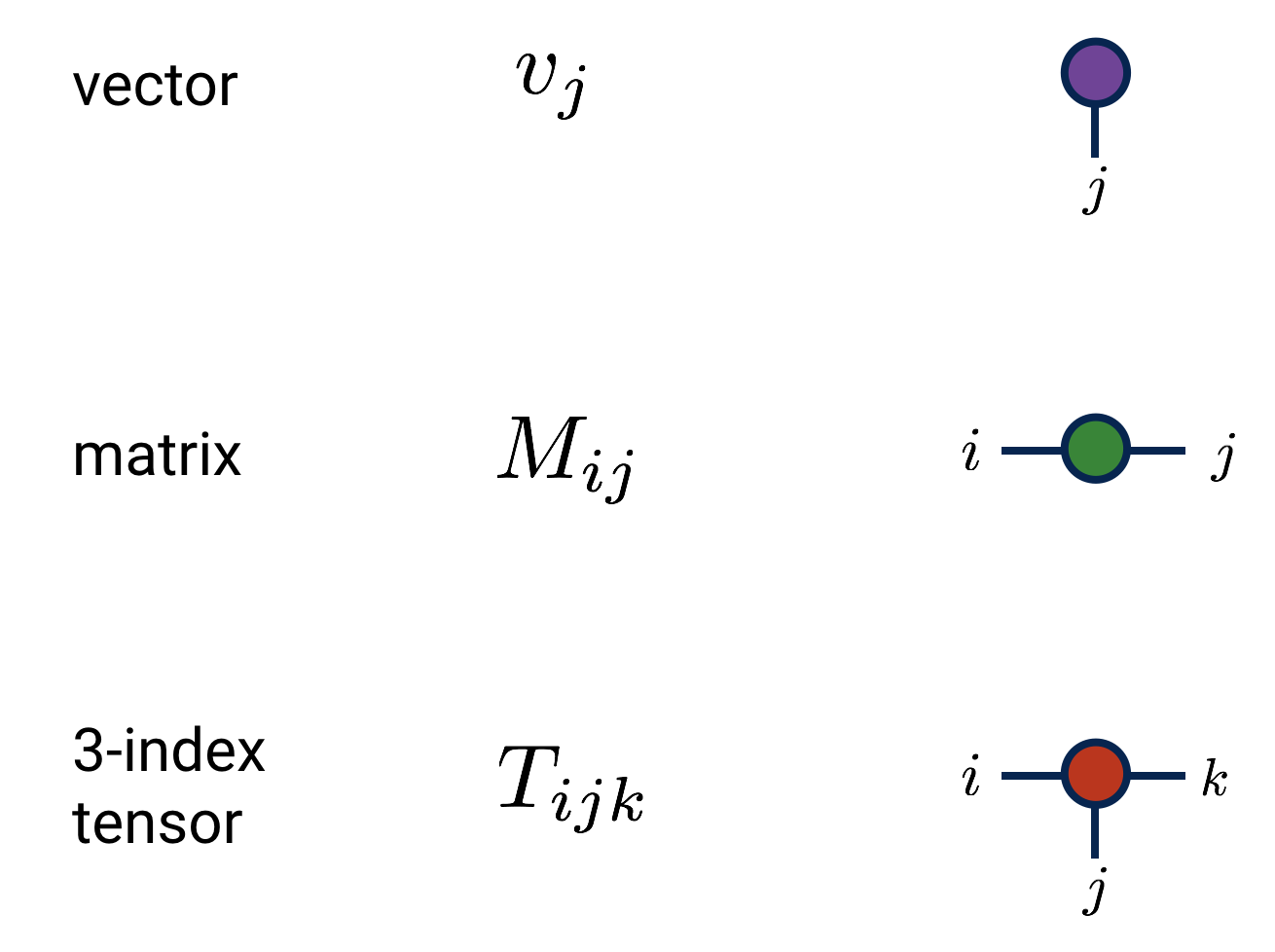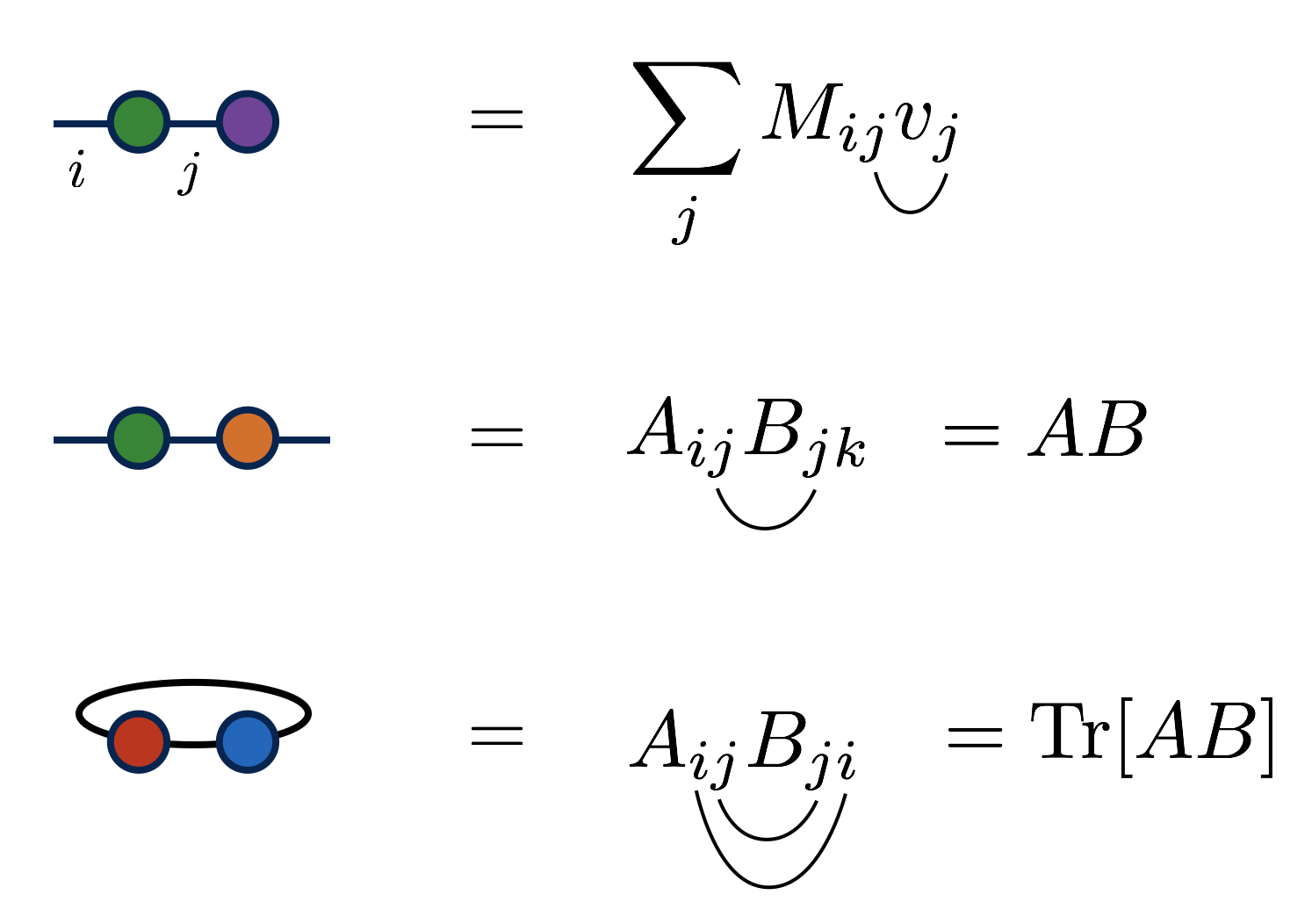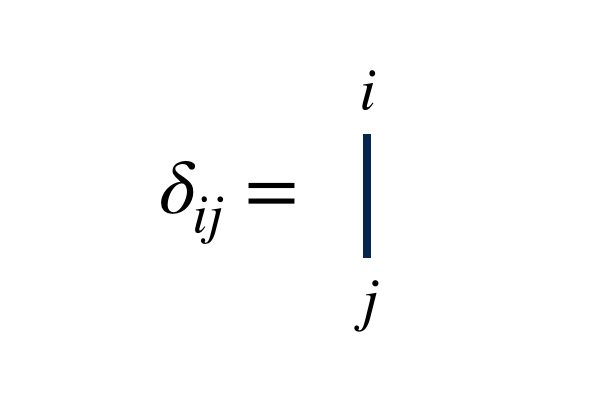
|
About Contribute Source |
| main/diagrams/ |
Tensor Diagram Notation
Tensor diagram notation[1][2][3] is a simple, yet powerful graphical notation for networks of contracted tensors.
A tensor contraction of the form $\sum_j M_{ij} N_{jkl}$ can be notated

Despite its graphical and intuitive nature, tensor diagram notation is completely rigorous and well defined: it is just a graphical notation for sums. It is inspired by the Einstein summation convention for notating tensor contractions.
Tensor Diagram Rules
There are two primary rules of tensor diagrams:
-
Tensors are notated by shapes (usually filled or shaded), and tensor indices are notated by lines emanating from these shapes.
-
Connecting two index lines implies a contraction, or summation over the connected indices.
Other conventions are often adopted by certain authors or in specific contexts. For example, using shapes or shadings to designate properties of tensors; orienting index lines according to certain conventions; or putting arrows on lines to distinguish contravariant and covariant indices.
Though it can be helpful to label indices and tensors with letters, it is optional to do so when the same information can be inferred from context. In fact, one of the main benefits of diagram notation is that it frees one from having to name every index in a complicated tensor network.
Examples
Let us look at some example diagrams for familiar low-order tensors:

And some examples of matrix-like contractions:

As well as tensor contractions:

In some examples above, the names of the indices are notated on the diagram. But the other examples emphasize that this is optional.
Identity Matrices
Because contracting a tensor over one of its indices with the identity matrix has no effect, it is customary to notate identity matrices just as plain lines with no “blob” or “shape” as with other tensors. Diagrammatically, this looks like:

This notation is useful, because the diagram for contracting with an identity matrix just extends an index line i.e. has no effect on the tensor:

Advantages of Tensor Diagram Notation
Tensor diagram notation has many benefits compared to other notations:
-
Various operations, such as a trace, tensor product, or tensor contraction can be expressed simply without extra notation.
- Placing tensors next to each other denotes a tensor/outer product.

- Connecting two index lines of the same tensor corresponds to a trace.

- Connecting index lines of different tensors denotes a tensor contraction.
- Placing tensors next to each other denotes a tensor/outer product.
-
Names of indices and tensors can often be omitted. This saves time and lightens the notation, and is especially useful for internal indices which exist mainly to be summed over.
-
The order of the tensor resulting from a complicated network of contractions can be determined by inspection: it is just the number of unpaired lines. For example, a tensor network with all lines joined, no matter how complicated, must result in a scalar.
Advanced, Extended, or Optional Diagram Notations
-
Notating contravariant versus covariant (“up and down”) indices can be accomplished by putting ingoing or outgoing arrows onto index lines
-
Special kinds of tensors can be designated using shapes or decorations. For example, isometric tensors are often drawn as triangles in the physics literature, and unitary tensors as rectangles. Diagonal tensors can be notated by having a diagonal line slashing through the middle of the shape.
-
Hyper-edges or multiple indices which are “locked” together can be notated by introducing “Kronecker delta” or “spider” tensors, often notated by small black dots. These tensors can have an arbitrary number of indices, and have only diagonal element all equal to one.
Other Resources
The diagram notation used in the tensor network literature is relatively informal and has quite a range of variation, but more formal specifications have been proposed.
A helpful introduction to diagram notation as it is used in quantum physics is given by Bridgeman and Chubb.[4]
References
- Applications of negative dimensional tensors, Roger Penrose, Combinatorial mathematics and its applications 1, 221-244 (1971)
- Group Theory, Birdtracks, Lie’s, and Exceptional Groups, Predrag Cvitanovic, Princeton University Press (2008)
- Matrices as Tensor Network Diagrams, Tai-Danae Bradley, Math3ma
- Hand-waving and interpretive dance: an introductory course on tensor networks, Jacob C Bridgeman, Christopher T Chubb, Journal of Physics A: Mathematical and Theoretical 50, 223001 (2017), arxiv:1603.03039
Edit This Page